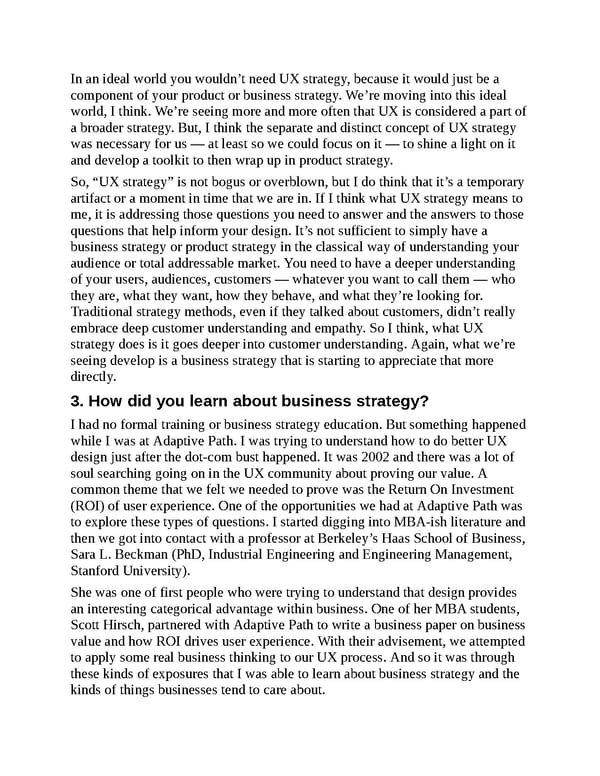In an ideal world you wouldn’t need UX strategy, because it would just be a component of your product or business strategy. We’re moving into this ideal world, I think. We’re seeing more and more often that UX is considered a part of a broader strategy. But, I think the separate and distinct concept of UX strategy was necessary for us — at least so we could focus on it — to shine a light on it and develop a toolkit to then wrap up in product strategy. So, “UX strategy” is not bogus or overblown, but I do think that it’s a temporary artifact or a moment in time that we are in. If I think what UX strategy means to me, it is addressing those questions you need to answer and the answers to those questions that help inform your design. It’s not sufficient to simply have a business strategy or product strategy in the classical way of understanding your audience or total addressable market. You need to have a deeper understanding of your users, audiences, customers — whatever you want to call them — who they are, what they want, how they behave, and what they’re looking for. Traditional strategy methods, even if they talked about customers, didn’t really embrace deep customer understanding and empathy. So I think, what UX strategy does is it goes deeper into customer understanding. Again, what we’re seeing develop is a business strategy that is starting to appreciate that more directly. 3. How did you learn about business strategy? I had no formal training or business strategy education. But something happened while I was at Adaptive Path. I was trying to understand how to do better UX design just after the dot-com bust happened. It was 2002 and there was a lot of soul searching going on in the UX community about proving our value. A common theme that we felt we needed to prove was the Return On Investment (ROI) of user experience. One of the opportunities we had at Adaptive Path was to explore these types of questions. I started digging into MBA-ish literature and then we got into contact with a professor at Berkeley’s Haas School of Business, Sara L. Beckman (PhD, Industrial Engineering and Engineering Management, Stanford University). She was one of first people who were trying to understand that design provides an interesting categorical advantage within business. One of her MBA students, Scott Hirsch, partnered with Adaptive Path to write a business paper on business value and how ROI drives user experience. With their advisement, we attempted to apply some real business thinking to our UX process. And so it was through these kinds of exposures that I was able to learn about business strategy and the kinds of things businesses tend to care about.
 UX Strategy: How to Devise Innovative Digital Products that People Want Page 290 Page 292
UX Strategy: How to Devise Innovative Digital Products that People Want Page 290 Page 292